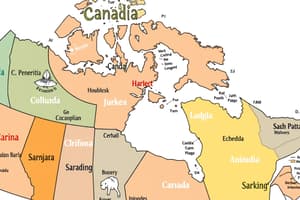Podcast
Questions and Answers
During the Industrial Revolution, why did people start moving from the countryside to cities?
During the Industrial Revolution, why did people start moving from the countryside to cities?
- To take jobs in industrial manufacturing operations (correct)
- To enjoy a quieter lifestyle in urban areas
- To escape natural disasters in rural areas
- To have access to better healthcare facilities
What percentage of Canadians lived in cities or towns in 1901?
What percentage of Canadians lived in cities or towns in 1901?
- 81%
- 13%
- 50%
- 37% (correct)
Which factor is NOT mentioned as contributing to the constant adaptation and change in cities, towns, and regions?
Which factor is NOT mentioned as contributing to the constant adaptation and change in cities, towns, and regions?
- Economy
- Technological advancements (correct)
- Climate change
- Migration patterns
What was the approximate population of Canada's urban areas in 1851?
What was the approximate population of Canada's urban areas in 1851?
Which event marked a significant increase in the urban population of Canada?
Which event marked a significant increase in the urban population of Canada?
What was the most notable change in the percentage of Canadians living in cities between 1851 and 2011?
What was the most notable change in the percentage of Canadians living in cities between 1851 and 2011?
Which statement best summarizes the relationship between urban and rural populations based on the text?
Which statement best summarizes the relationship between urban and rural populations based on the text?
Which Canadian provinces are considered the country's manufacturing and industrial heartland?
Which Canadian provinces are considered the country's manufacturing and industrial heartland?
Where are large urban areas in eastern Canada, like Halifax and Moncton, typically located?
Where are large urban areas in eastern Canada, like Halifax and Moncton, typically located?
What agricultural products does Canada export around the world?
What agricultural products does Canada export around the world?
Which region of Canada has the rich soil suitable for agriculture similar to the U.S. prairies?
Which region of Canada has the rich soil suitable for agriculture similar to the U.S. prairies?
What type of wilderness dominates much of the uninhabited land in Canada?
What type of wilderness dominates much of the uninhabited land in Canada?
Where do most of North America's bird species find their habitats in Canada?
Where do most of North America's bird species find their habitats in Canada?
What is one of the main threats to the untouched wilderness of the Canadian arctic?
What is one of the main threats to the untouched wilderness of the Canadian arctic?
During the Industrial Revolution, what led people to leave the countryside and move to cities in Canada?
During the Industrial Revolution, what led people to leave the countryside and move to cities in Canada?
What was the approximate percentage of Canadians living in cities or towns in 1851?
What was the approximate percentage of Canadians living in cities or towns in 1851?
How did the urban population change between 1851 and 1901 in Canada?
How did the urban population change between 1851 and 1901 in Canada?
What percentage of Canadians lived in urban areas by 2011?
What percentage of Canadians lived in urban areas by 2011?
Which factor played a significant role in the urbanization of Canada during the late 18th and early 19th centuries?
Which factor played a significant role in the urbanization of Canada during the late 18th and early 19th centuries?
What was one of the major impacts of the Industrial Revolution on Canada's population distribution?
What was one of the major impacts of the Industrial Revolution on Canada's population distribution?
What characterized the relationship between urban and rural populations in Canada during the Industrial Revolution?
What characterized the relationship between urban and rural populations in Canada during the Industrial Revolution?
Which region in Canada tends to have urban areas concentrated on fishing and shipping?
Which region in Canada tends to have urban areas concentrated on fishing and shipping?
What is the primary agricultural activity in the Canadian prairies?
What is the primary agricultural activity in the Canadian prairies?
Which Canadian province has large urban areas that were not primarily centered around manufacturing?
Which Canadian province has large urban areas that were not primarily centered around manufacturing?
What poses a significant threat to the wildlife in the Canadian prairies due to extensive farmland conversion?
What poses a significant threat to the wildlife in the Canadian prairies due to extensive farmland conversion?
Which factor contributes to the challenges faced by the untouched wilderness of the Canadian arctic?
Which factor contributes to the challenges faced by the untouched wilderness of the Canadian arctic?
Where do most fruits and vegetables in Canada get cultivated due to favorable conditions?
Where do most fruits and vegetables in Canada get cultivated due to favorable conditions?
Which wilderness area in Canada comprises primarily evergreen forests supporting rich biodiversity?
Which wilderness area in Canada comprises primarily evergreen forests supporting rich biodiversity?
What industry views the untouched wilderness of the Canadian arctic as a potential source for development?
What industry views the untouched wilderness of the Canadian arctic as a potential source for development?
Flashcards are hidden until you start studying




